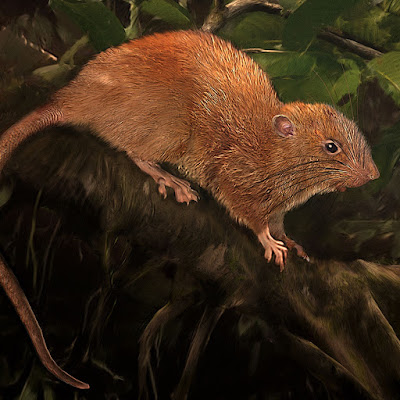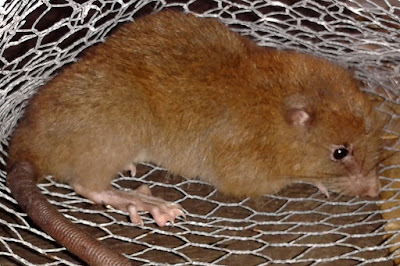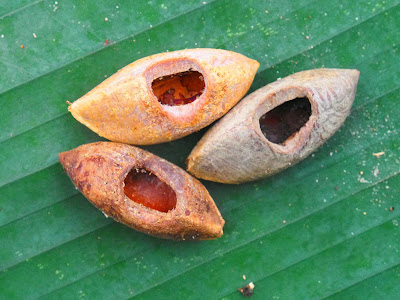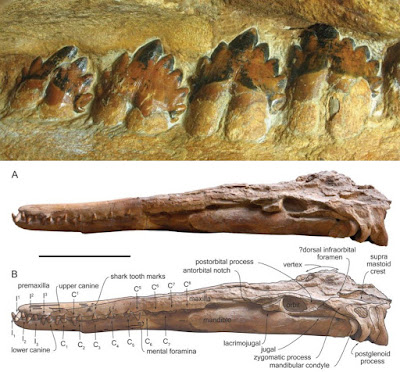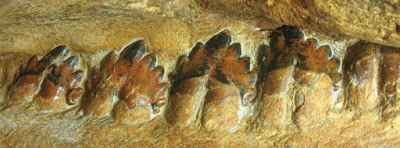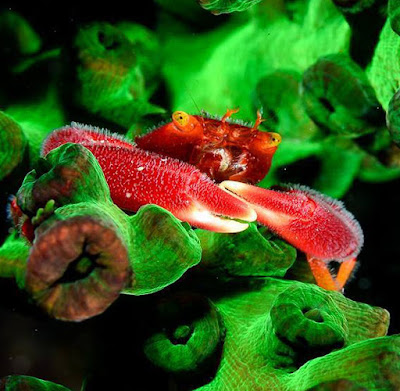[Most Recent Entries] [Calendar View]
Thursday, September 28th, 2017
| Time | Event | ||||||
| 1:22p | [Mammalogy • 2017] Uromys vika • A New Species of Giant Rat (Muridae, Uromys) from Vangunu, Solomon Islands
Abstract We describe the first new rodent species from Solomon Islands in more than 80 years. This new giant rat is known from a single specimen captured in a commercially felled Dillenia salomonensis tree on Vangunu Island. Morphologically, it closely resembles a fascinating secondary radiation of 3 species of Uromys (Cyromys) that are endemic to Guadalcanal Island. The cranium can be readily distinguished from those of other species of Uromys by its shorter maxillary tooth row, and shorter incisive foramina. The existence of this species has been suspected for over 2 decades. It is rare and cryptic, and conservation status is Critically Endangered due to its small distributional range, apparent low population densities, and rapid progress of commercial logging on Vangunu Island. Further surveys to locate additional animals and support for community led conservation initiatives on Vangunu are urgently needed to safeguard the species. Keywords: arboreal, endangered, endemic, Guadalcanal, logging, Marovo, Melanesia, Pacific, rodent
Tyrone H. Lavery and Hikuna Judge. 2017. A New Species of Giant Rat (Muridae, Uromys) from Vangunu, Solomon Islands. Journal of Mammalogy. gyx116. DOI: 10.1093/jmammal/gyx116 Giant Rat That Fell From Sky Is New Species on.natgeo.com/2xEOCBG via @NatGeo Solomon Islands expedition seeks to conserve the extraordinary monkey-faced bat and giant rat theconversation.com/solomon-islands-expe Report ia, hemi wanfala scientific description blo wanfala new species lo giant (bigfala) rat blo Vangunu Aelan, Solomon Aelans. Oketa man callim disfala rat, “vika.” Disfala species hemi garem wanfala specimen nomoa. Wanfala man outim lo kapuchu tree taem oketa daunim ya tree lo logging area. Lukluk blo rat ya hem kolosap lo trifala rat blo Guale, bata hemi garem sumfala important difference lelebet lo body and skull blo hem. Vika hemi garem leki wea hemi wide tumus wetem 7 fala pad undanit, hem no 6 fala osem oketa rat blo Guale. Color blo body blo hem, hemi braun wetem waet lo undanit. Skull blo hem, hemi short wantaem wide. Baek teeti blo hem, oketa short tumus and sumfala hol behaenim oketa front teeti, hemi short tumus too. Disfala vika hemi barava hard tumus fo faendim. Oketa man blo Vangunu save lo hem long taem finis, anda oketa scientist save lo hem ovum 20 ias finis, bata diswan hemi first vika for oketa scientist lukim. Mifala garem tingting hemi kolsap extinct (finis), kaen hem luk olsem vika no save stap lo eni ples wea logging hemi kasim finis. Iumi mus lukaotim gud bus blo Vangunu anda halipim oketa man blo Zaira for kipim gud bus blo oketa. | ||||||
| 1:44p | [PaleoMammalogy • 2017] Inticetus vertizi • A New Odontocete (Toothed Cetacean) from the Early Miocene of Peru Expands the Morphological Disparity of Extinct Heterodont Dolphins Abstract A key step in the evolutionary history of Odontoceti (echolocating toothed cetaceans) is the transition from the ancestral heterodont condition – characterized by the presence of double-rooted cheek teeth bearing accessory denticles – to the homodont dentition displayed by most extant odontocete species. During the last few decades, new finds and the reassessment of specimens in collections revealed an increased morphological disparity amongst the Oligo–Miocene heterodont odontocetes. Based on a partly articulated skeleton from late Early Miocene (Burdigalian, 18.8–18.0 Ma) beds of the Chilcatay Formation (Pisco Basin, Peru), we describe a new genus and species of heterodont odontocete, Inticetus vertizi, in the new family Inticetidae. This large dolphin is characterized by, amongst other things, a long and robust rostrum bearing at least 18 teeth per quadrant; the absence of procumbent anterior teeth; many large, broad-based accessory denticles in double-rooted posterior cheek teeth; a reduced ornament of dental crowns; the styliform process of the jugal being markedly robust; a large fovea epitubaria on the periotic, with a correspondingly voluminous accessory ossicle of the tympanic bulla; and a shortened tuberculum of the malleus. Phylogenetic analyses (with and without molecular constraint; with and without down-weighting of homoplastic characters) yielded contrasting results, with Inticetus falling either as a stem Odontoceti or as an early branching member of a large Platanistoidea clade. With its large size, robust rostrum and unusual dental morphology, and the absence of conspicuous tooth wear, Inticetus increases the morphological and ecological disparity of Late Oligocene–Early Miocene heterodont odontocetes. Finally, this new taxon calls for caution when attempting to identify isolated cetacean cheek teeth, even at the suborder level. Keywords: Cetacea, Odontoceti, heterodont, Miocene, Burdigalian, Peru
Systematic palaeontology Pelagiceti Uhen, 2008a Neoceti Fordyce & Muizon, 2001 Suborder Odontoceti Flower, 1867 Family Inticetidae fam. nov. Type genus. Inticetus gen. nov. Genus Inticetus gen. nov. Type species. Inticetus vertizi sp. nov. Derivation of name. From Inti, the sun deity of the Inca Empire, and cetus, whale in Latin, for the typical, subcircular and ray-like arrangement of accessory denticles in posterior cheek teeth of MUSM 1980, reminiscent of artistic reconstructions of the rising sun. Inticetus vertizi sp. nov. Derivation of name. Honouring the discoverer of the holotype MUSM 1980, the Peruvian artist Álvaro Suárez Vértiz. Olivier Lambert, Christian de Muizon, Elisa Malinverno, Claudio Di Celma, Mario Urbina and Giovanni Bianucci. 2017. A New Odontocete (Toothed Cetacean) from the Early Miocene of Peru Expands the Morphological Disparity of Extinct Heterodont Dolphins. Journal of Systematic Palaeontology. DOI: 10.1080/14772019.2017.1359689 | ||||||
| 2:03p | [Crustacea • 2017] Two New Records of the Coral Symbiont Crab Genus Quadrella Dana, 1851 (Brachyura: Trapeziidae), from Taiwan, with Notes on the Taxonomy of Q. boopsis Alcock, 1898
Abstract Two symbiotic trapeziid crabs of the genus Qudrella Dana, 1851, were collected from southwestern Taiwan. Both are new records for the island. Quadrella coronata Dana, 1852, is usually associated with the soft coral Chironephthya spp., while Q. boopsis Alcock, 1898, was found with the scleractinian coral Tubastraea micrantha. The taxonomy of Q. boopsis is treated and the variation in the dorsal surface of the carapace, armature of the anterolateral margin and colour pattern discussed. Keywords: Crustacea, Quadrella, taxonomy, new records, East Asia, Trapeziidae Chia-Wei Lin and Peter K. L. Ng. 2017. Two New Records of the Coral Symbiont Crab Genus Quadrella Dana, 1851, from Taiwan, with Notes on the Taxonomy of Q. boopsis Alcock, 1898 (Crustacea: Brachyura: Trapeziidae). Zootaxa. 4324(3);571–580. DOI: 10.11646/zootaxa.4324.3.10 |
| << Previous Day |
2017/09/28 [Calendar] |
Next Day >> |
